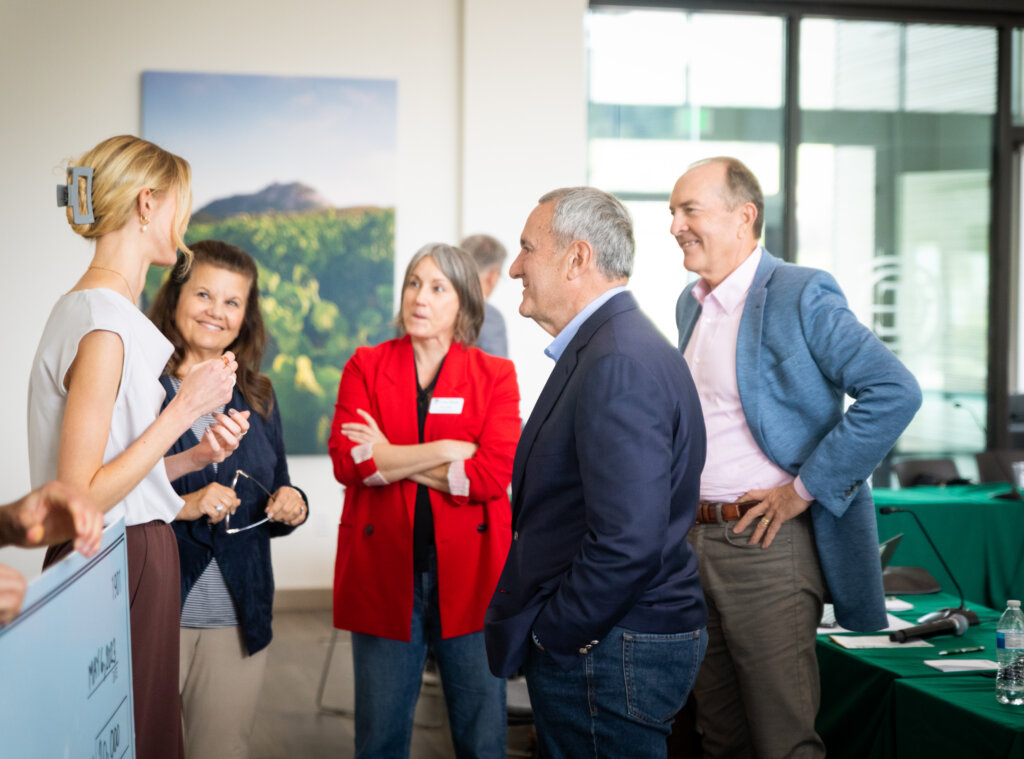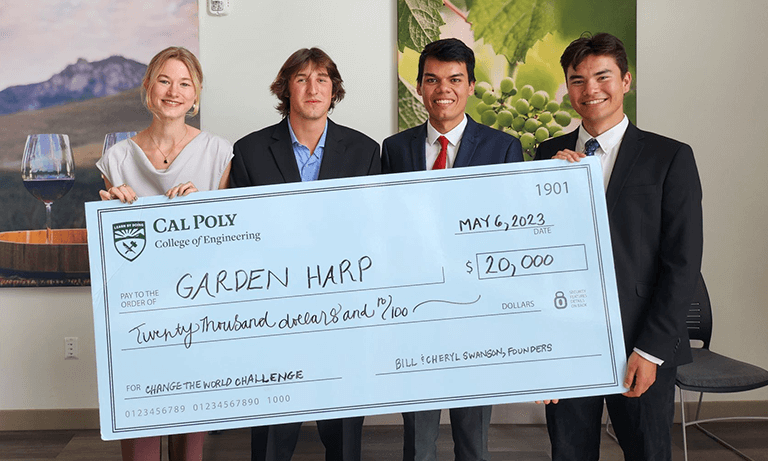Four Cal Poly students received $20,000 to implement their research idea through the Change the World Challenge, an interdisciplinary competition sponsored by Bill Swanson, a College of Engineering 1973 industrial engineering alumnus and retired Raytheon chairman and CEO.
Luke Bowen (environmental management and protection), Liam Drew (mechanical engineering), Sam Hudson (mechanical engineering) and Amelia Stonkus (biological sciences, environmental earth and soil sciences) impressed judges with their project, Garden Harp, an environmentally friendly planter that captures moisture from fog to water gardens.

“The Garden Harp is a home garden structure that combines an olla irrigation system and a fog harp,” Stonkus described.
The prototype connects three arrays of vertical steel wires with bamboo rods that are planted into the soil. When fog passes through, the water droplets from the fog connect to the steel rods and distribute into the soil.
The Change the World Challenge encourages students to focus on real-world problems and create solutions while working within interdisciplinary teams.
“The challenge’s intent uses system engineering principles in solving problems the team thinks can and should make a difference in today’s world,” Swanson said. “That is what truly makes this the type of challenge that will change the world. It was very encouraging to see the advanced level of thinking this year by all teams.”
Student participants received support from a group of interdisciplinary mentors including Christina Firpo, history; Eric Sapper, chemistry and biochemistry; Miranda Yin, marketing; Jill Speece, industrial and manufacturing engineering; and Priya Verma, natural resources management and environmental sciences, who provided valuable feedback from project conception to completion throughout the fall quarter. Dawn Neill, interim vice president of research at Cal Poly, and Rebekah Oulton, civil and environmental engineering associate professor, serve as the competition’s founding directors.
The culminating Change the World Challenge event on May 6 allowed the students to present their ideas to a panel of judges, including Swanson, Susie Armstrong (Computer Science, ’82), Chuck Harrington (Agricultural Education and Communication, ’81) and Kathleen Holmgren (Industrial Engineering, ’80).

Sam Hudson (mechanical engineering), Amelia Stonkus (biological sciences, environmental earth & soil sciences), Liam Drew (mechanical engineering) and Luke Bowen (environmental management & protection) share in their excitement after winning first place and $20,000 in the Change the World Challenge for their project, Garden Harp. Andy Sherar/Student Assistant Photographer/Cal Poly 5-6-23
“The Change the World Challenge is an excellent way of broadening your skills and making you more able to think through problems and the wide implications of those problems,” Hudson said.
Three more teams earned funding to further their project efforts. Amelia Cameron (mechanical engineering), Penny Lane Case (business entrepreneurship), Sydney Fairchild (mechanical engineering), Stefany James (mechanical engineering) and Thaddeus Ziarkowski (business entrepreneurship) placed second for their project, “Ourcelium” and earned $10,000. The judges granted third place and $5,000 to Kellen Barsley (industrial engineering), Kate Danis (biological sciences), Rebecca Li (civil engineering) and Sophie Ortiz (environment earth and soil sciences) for their project “Reclaimed Energy.” Honorable mention and a $1,000 award went to Abigail Christensen (environmental management and protection), Amanda Ortega (environmental management and protection) and Ronit Singh (electrical engineering) for “The Plastic Pyrolyzer.”
“Not only is the competition a way to spark innovation, but it also provides students with the chance to focus on their unique areas of interest,” Swanson said.
By Taylor Villanueva


